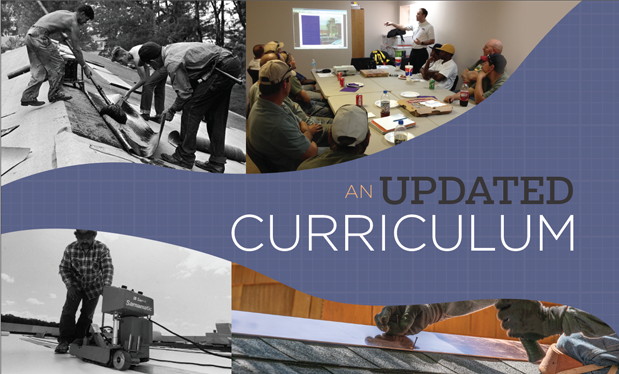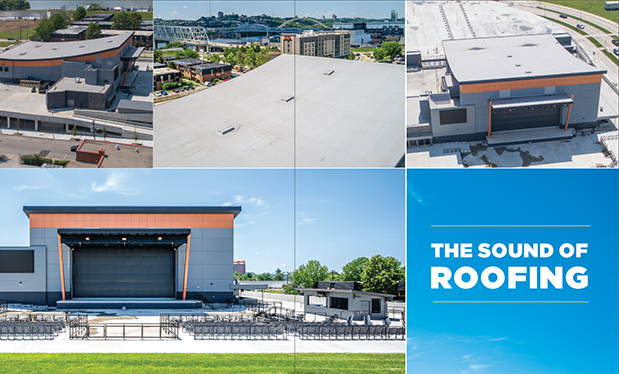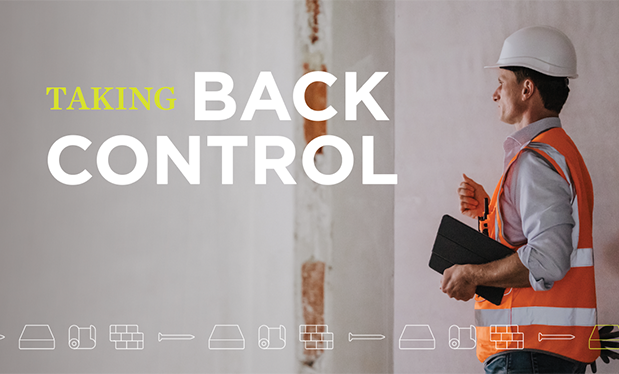The International Code Council® promulgates a comprehensive set of 14 model building codes that serve as the basis for most jurisdictions’ construction codes. ICC’s codes are updated and published on a three-year cycle with the most current editions having a 2021 edition date.
In the April issue, I discussed the roofing-related changes incorporated into the International Building Code,® 2021 Edition; International Existing Building Code,® 2021 Edition and International Fire Code,® 2021 Edition. Here, I will provide an overview of the roofing-related changes incorporated into the International Energy Conservation Code,® 2021 Edition; International Plumbing Code,® 2021 Edition; and International Residential Code® for One- and Two-Family Dwellings, 2021 Edition.
IECC 2021
IECC 2021 contains two sets of provisions: commercial and residential.
IECC’s commercial provisions apply to all buildings except residential buildings three stories or less in height. IECC’s residential provisions apply to detached one- and two-family dwellings as well as Group R-2, R-3 and R-4 buildings three stories or less in height. IECC’s commercial provisions apply to residential buildings four stories or greater in height.
IECC’s commercial provisions are designated having a “[CE]” in chapter numbering and a “C” in section numbering. Residential provisions are designated having an “[RE]” in chapter numbering and an “R” in section numbering.
IECC’s commercial provisions
IECC 2021’s roofing-related provisions applicable to commercial buildings occur in Chapter 3[CE]—General Requirements, Chapter 4[CE]—Commercial Energy Efficiency and Chapter 5[CE]—Existing Buildings.
In Chapter 3[CE], the climate zone map has been revised. Climate Zone 0 has been added, and the climate zones in the continental U.S. have shifted slightly northward. Figure C301.1—Climate Zones provides a climate zone map. ICC reports about 10% of counties’ and parishes’ climate zones have changed. Table C301.1—Climate Zones, Moisture Regimes, and Warm Humid Designations by State, County and Territory provides a list of climate zones. Counties and parishes in this table with a revision bar in the margin indicate climate zone changes from IECC 2018.
In Chapter 4[CE]—Commercial Energy Efficiency, Section C401.2—Application, the explanation of compliance options has been reformatted and reworded. There are two compliance options: a prescriptive option, which requires compliance with Sections C402 through C406 and Section C408, and a total building performance option, which requires compliance with Section C407.
An alternative compliance option also is available: complying with ANSI/ASHRAE/IESNA 90.1-19, “Energy Standard for Buildings Except Low-Rise Residential Buildings.”
Repairs to roof systems and reroofing are addressed in Chapter 5[CE]—Existing Buildings.
Table C402.1.3—Opaque Thermal Envelope Insulation Component Minimum Requirements, R-value Method, provides minimum R-values for building components, including roof assemblies, applicable when using IECC’s prescriptive compliance option. For roof components designated as “attic and other,” the minimum required R-values have increased to R-49 in Climate Zones 4 and 5 and R-60 in Climate Zones 7 and 8. In Climate Zone 8 for roof components designated as “metal buildings,” the minimum required R-values have increased to R-25 and R-11 layers and an additional R-11 layer, which includes a liner system.
Similar increases (those being reductions in U-factors) are incorporated into IECC 2021’s maximum U-factor table, Table C402.1.4-Opaque Thermal Envelope Assembly Maximum Requirements, U-factor Method.
In Section 402.1.4—Assembly U-factor, C-factor or F-factor-based Method, a new section has been added to the prescriptive compliance option allowing the U-factor method to be used for roof/ceiling assemblies. Section C402.1.4.1—Roof/Ceiling Assembly now provides specific requirements for using above-deck tapered insulation, suspended ceilings and above-deck insulation in two or more layers with joints staggered.
In Section C402.2-Specific Building Thermal Envelope Insulation Requirements, changes have been made to the prescriptive compliance option’s R-value method. Section C402.2.1.1—Tapered, Above-Deck Insulation Based on Thickness now allows the R-value of tapered insulation systems to be calculated on the average R-value method. The minimum thickness at a low point is 1 inch.
Section C402.2.1.3—Suspended Ceilings stipulates insulation, such as batt insulation, installed on removeable ceiling tiles is not permitted to be considered toward the minimum required R-value.
Section C402.2.1.4—Joints Staggered requires above-deck thermal insulation to be installed in two or more layers with edge joints staggered between each layer except where roof insulation tapers at gutter edges, roof drains and scuppers.
There are no changes in IECC 2021’s requirements for roof reflectance and solar emittance.
Regarding air retarders (IECC refers to them as air barriers), in Section C402.5.1.2—Air Barrier Compliance, the applicability of IECC 2021’s air retarder requirements have changed somewhat. The code’s air retarder requirements are required in all occupancies except Groups R and I are exempted in Climate Zones 0B, 1, 2B, 3B, 3C, 4B, 4C, 5B and 5C in specifically defined circumstances. In IECC 2018, the air retarder requirements applied to all buildings except in Climate Zone 2B.
In Section C402.5.1.4—Assemblies, ASTM D8052, “Standard Test Method for Quantification of Air Leakage in Low-Sloped Membrane Roof Assemblies,” has been added as an additional test method for determining the air leakage of building assemblies.
Section C402.5.1.5—Building Envelope Performance Verification provides new requirements for performance verification of installed air retarders. Separate guidance is provided for construction document review, inspection of accessible components and final commissioning.
Section 402.5.3—Building Thermal Envelope Testing provides new requirements for testing a building envelope’s air retarder effectiveness.
Roof system repairs and reroofing are addressed in IECC 2021’s Chapter 5[CE]-Existing Buildings. In Section C503.2.1—Roof Replacement, a requirement is added indicating a roof assembly’s R-value shall not be decreased or U-factor increased because of roof system replacement. Because this section already requires insulation levels identical to IECC 2021’s for new construction, it appears this added requirement is intended to address existing buildings with insulation levels exceeding the code’s current requirements.
IECC’s residential provisions
IECC 2021’s roofing-related provisions applicable to residential buildings occur in Chapter 3[RE]—General Requirements, Chapter 4[RE]—Residential Energy Efficiency and Chapter 5[RE]—Existing Buildings.
In Chapter 3[RE]—General Requirements, the same changes made to the climate zones in Chapter 3[CE]—General Requirements also apply.
In Chapter 4[RE]—Residential Energy Efficiency, Section R401.2—Application, the explanation of the permissible compliance paths has been reformatted and reworded.
There are four compliance options:
- A prescriptive option, which requires compliance with Sections R401 through R404
- A total building performance option, which requires compliance with Section R405
- An Energy Rating Index option, which requires compliance with Section R406
- A tropical climate region option, which requires compliance with Section R407
Repairs to roof systems and reroofing are addressed in Chapter 5[RE]—Existing Buildings.
For the prescriptive compliance path, clarifying language has been added in Section R402.1.4—R-value Computation addressing R-value calculation methods and in Section R402.2.3—Eave Baffle addressing continuous vent baffle installation.
There are no roofing-specific revisions to IECC 2021’s total building performance, Energy Rating Index option and tropical climate region options. Similarly, there are no revisions to IECC 2021’s requirements for roof system repairs and reroofing in IECC 2021’s Chapter 5[RE]-Existing Buildings.
IPC 2021
IPC 2021 provides minimum requirements for buildings’ plumbing systems, including roof drains. Roof drains, drain piping, parapet wall scuppers, gutters and other secondary roof drains are addressed in IPC 2021’s Chapter 11—Storm Drainage.
Section 1102.6—Roof Drains now requires roof drains, other than siphonic roof drains, to be tested and rated for flow rate according to ASME A112.6.4, “Roof, Deck, and Balcony Drains,” or ASPE/IAPMO Z1034, “Test Method for Evaluating Roof Drain Performance.” Roof drain manufacturers should publish flow rate data for their specific roof drain models and sizes.
In Section 1106.2—Size of Storm Drain Piping and Section 1106.2.1—Rainfall Rate Conversion Method, a method has been added for converting rainfall intensity to flow rate for code-compliant drain piping sizing.
IRC 2021
IRC 2021 applies to detached one- and two-family dwellings and townhouses not more than three stories in height with separate means of egress.
Most of IRC 2021’s roofing-related content is contained in Chapter 9—Roof Assemblies.
In Section R902—Fire Classification, new fire testing requirements have been added for rooftop-mounted photovoltaic products. Building-integrated PV products, such as PV shingles, are required to be tested, listed and labeled using UL 7103, “Outline of Investigation for Building-integrated Photovoltaic Roof Coverings.” Roof-mounted PV panel systems are required to be tested, labeled and identified using UL 2703, “Mounting Systems, Mounting Devices, Clamping/Retention Devices, and Ground Lugs for Use with Flat-plate Photovoltaic Modules and Panels.” Both UL 7103 and UL 2703 provide for fire classification of roof-mounted PV systems as Class A, B or C.
In Section R905.1.1—Underlayment, the requirements for underlayment used in steep-slope roof systems have been revised. Self-adhering polymer-modified bitumen underlayment now is required to be labeled indicating compliance with ASTM D1970, “Specification for Self-adhering Polymer Modified Bituminous Sheet Materials Used as Steep Roofing Underlayment for Ice Dam Protection.” Also, in Exception 2 for sealed deck systems, underlayment application and attachment have been clarified as needing to be applied per Table R905.1.1(2) and (3)—Underlayment Application.
The two-layer sealed underlayment option that appeared in IRC 2018’s Exception 3 has been removed.
In Table R905.1.1.(1)—Underlayment Types and Table R905.1.1(2) and (3)—Underlayment Application, the applicability of the code’s high-wind requirements are clarified to apply when indicated on a map, Figure R301.2.1.1—Regions Where Wind Design is Required. This map indicates wind design is required where the design wind speed is 130 mph or greater along the Atlantic coastline from Florida to North Carolina and along the Gulf of Mexico. Wind design also is required along Alaska’s coastline where the design wind speed is 140 mph or greater.
In Section R905.3—Clay and Concrete Tile, the deck requirements have been revised to only allow spaced lumber sheathing in Seismic Design Categories A, B or C. Previously, the code permitted the use of tile over spaced lumber sheathing in all areas, including Seismic Design Category D.
In Section R905.4—Metal Roof Shingles, a requirement for wind resistance testing has been added. Metal roof shingles now are required to be tested for wind resistance according to one of the following standards:
- ASTM D3161, “Standard Test Method for Wind Resistance of Steep Slope Roofing Products (Fan-Induced Method)”
- FM 4474, “Standard for Evaluating the Simulated Wind Uplift Resistance of Roof Assemblies”
- UL 580, “Standard for Tests for Uplift Resistance of Roof Assemblies”
- UL 1897, “Standard for Safety, Uplift Tests for Roof Covering Systems”
Metal roof shingles tested using ASTM D3161 are required to comply with the classifications in Table R905.4.4.1—Classification of Steep Slope Metal Roof Shingles Tested in Accordance with ASTM D3161 and have package labeling indicating the tested classification.
Table R905.7.5(2)—Nail Requirements for Wood Shakes and Wood Shingles has been reformatted with the nail type, minimum length and shank diameter now consolidated into one column. Also, the nail for 18- and 24-inch taper-sawn shakes has been changed to a 6d x 2-inch x 0.099-inch box nail. The nail diameter for box nails has changed to 0.076 of an inch from 0.08 of an inch in the code’s previous editions.
In Section R905.16—Photovoltaic Shingles, a requirement has been added requiring PV shingles to comply with product standards UL 7103 or both UL 61730-1, “Standard for Photovoltaic (PV) Module Safety Qualification - Part 1: Requirements for Construction,” and UL 61730-2, “Photovoltaic (PV) Module Safety Qualification - Part 2: Requirements for Testing.” PV shingles also are required to be tested for wind resistance and be classified per a new Table R905.16.6-Classification of Photovoltaic Shingles, which requires wind classification Class A, D or F.
In Section R905.17—Building-integrated Photovoltaic Roof Panels Applied Directly to the Roof Deck, a new requirement has been added requiring PV shingles to comply with product standards UL 7103 or both UL 61730-1 and UL 61730-2.
In Section R906-Roof Insulation, NFPA 276, “Standard Method of Fire Test for Determining the Heat Release Rate of Roofing Assemblies with Combustible Above-Deck Roofing Components,” has been added and FM 4450, “Approval Standard for Class 1 Insulated Steel Roof Decks,” has been removed as an allowable fire test method.
Attic ventilation is addressed in IRC’s Chapter 8—Roof-Ceiling Construction. In Section R806—Roof Ventilation, the requirements for using air-impermeable insulation for dwellings and townhouses in Climate Zones 1, 2 and 3 have been clarified in Section R806.5, Item 5.2, Subitems 5.2.8 through 5.2.10.
GET THE I-CODES
As jurisdictions begin the process of updating their codes, you should be aware of the roofing-related changes incorporated into the 2021 I-Codes and have a copy of the applicable codes on hand.
You can purchase the 2021 I-Codes in soft cover or loose-leaf format or download them. ICC also offers a web-based version, Digital Codes Premium, which is available by either a monthly or annual subscription. To purchase the I-Codes, go to codes.iccsafe.org.
MARK S. GRAHAM is NRCA’s vice president of technical services.



